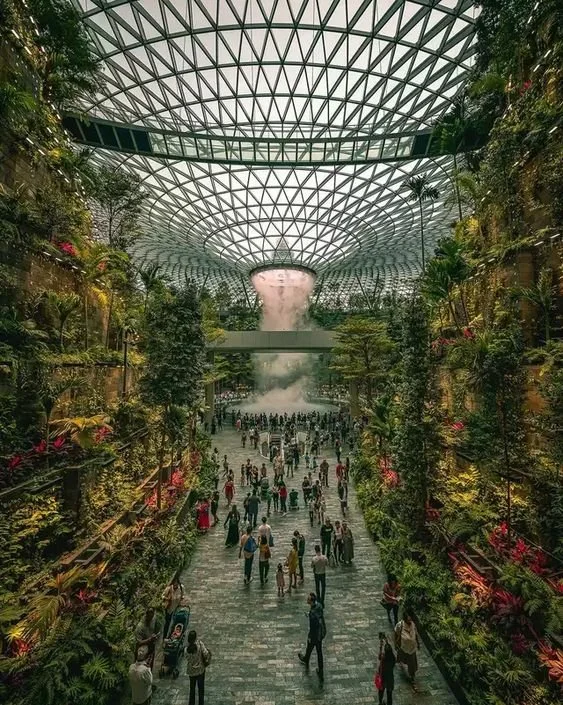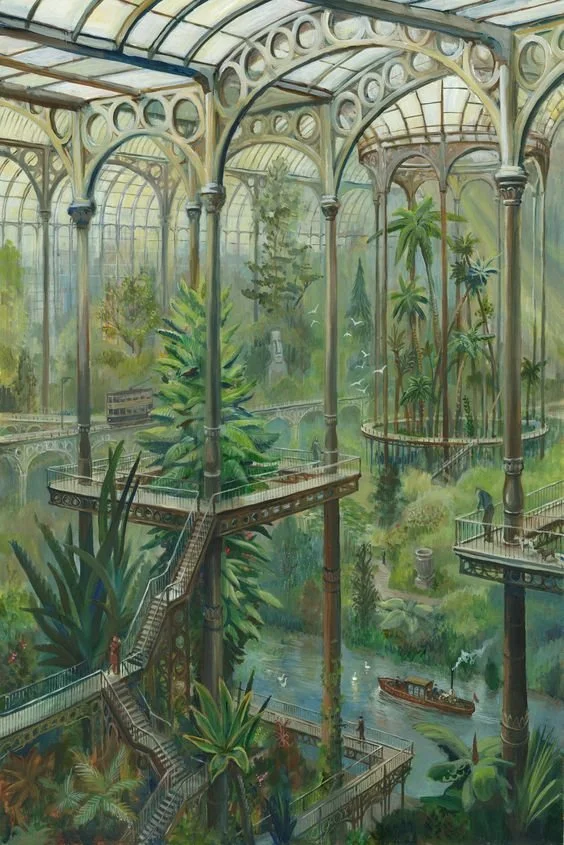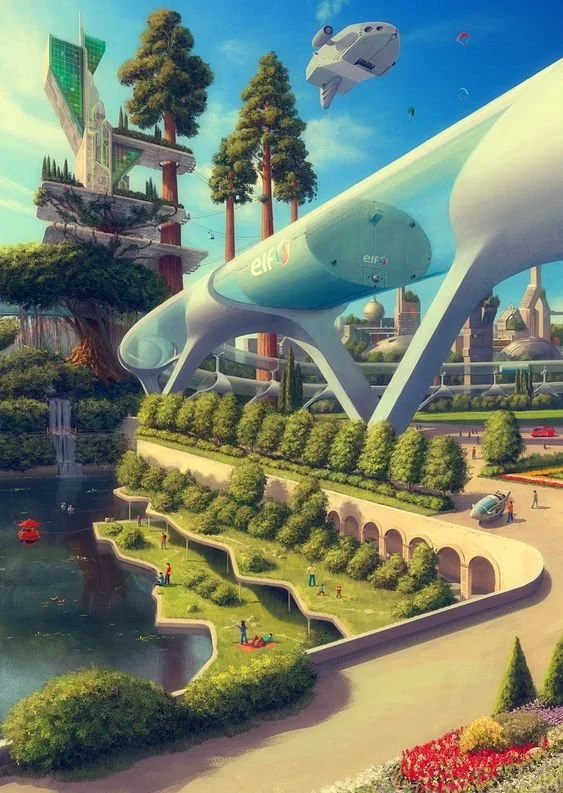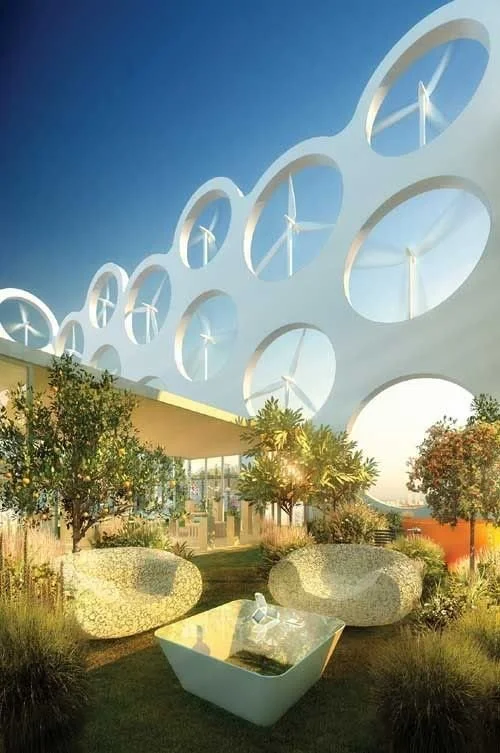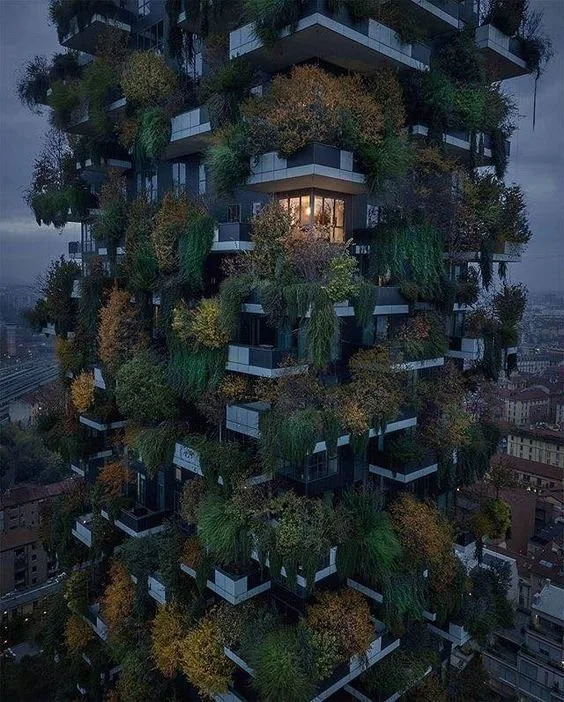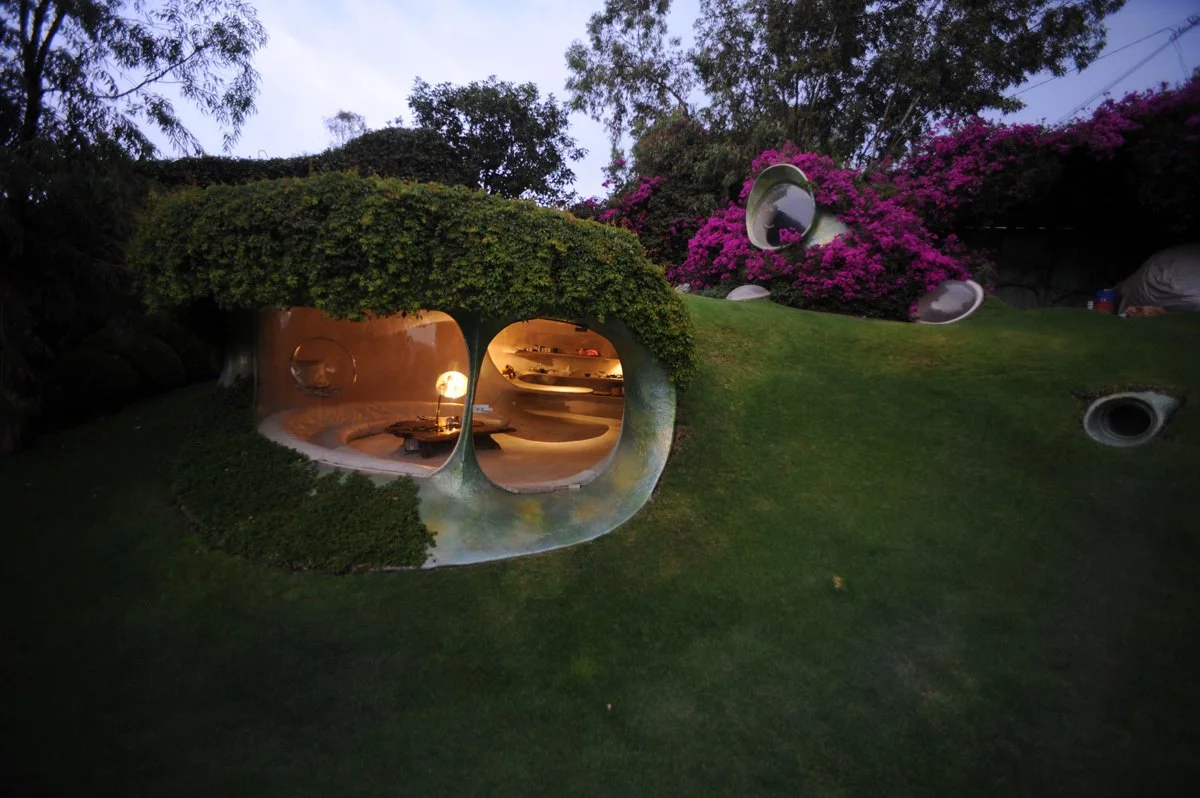Punk! But make it….Solar?
Introduction-
Now you probably know of Steampunk and Cyberpunk (and possibly some other -punk iterations), but you might not know of a younger, non-dystopian, and much greener, addition to the list. Solarpunk. The term and concept were first coined by an anonymous blog author in 2008, introduced in the article “From Steampunk to Solarpunk”. However, the idea gained more popularity in 2016/17 and, more recently, in 2021. Solarpunk is defined as “a genre and art movement that envisions how the future might look if humanity succeeded in solving major contemporary challenges with an emphasis on sustainability, climate change and (lack of) pollution”. Additionally, it is seen as an “aesthetic-cultural” and “ethical-political” theory/social movement. In his video titled “How We Can Make Solarpunk a Reality“, Saint Andrew describes Solarpunk as “A shining vision of a positive, communal future, grounded in our efforts in the existing world, that emphasizes the need for environmental sustainability, self-governance and social justice”. Solarpunk combines sustainable practices (such as green building, ethical agriculture and renewable energy), futuristic technology, and people based practices like community collaboration or mutual aid. Moreover, if you’re wondering: “What’s so “punk” about Solarpunk?”, that aspect comes from the “rebellion against the war on hope today”. Andrew explains “In this world, imagining and fighting for a solarpunk future goes contrary to everything those in power want for us.” And, despite how utopian this seems, a society of this nature is more than achievable if we all work towards it. Let's talk about what this means for us all, during revolutionary times like the ones we’re in now.
“Solarpunk”, Rita Fei (via ArtStation)
Studying Solarpunk-
The goal of solarpunk is to create a perfect balance between humanity and nature. By utilizing advanced technology to further sustainability, efficiency and quality of life, it seems to succeed. According to Solarpunk Anarchists, Solarpunk “draws a lot from the philosophy of social ecology, which also focused on mending this rift by restructuring society to function more like ecology: non-hierarchical, cooperative, diverse, and seeking balance. Solarpunk’s vision is of an ecological society beyond war, domination, and artificial scarcity; where everything is powered by green energy and a culture of hierarchy and exclusion has been replaced by a culture founded on radical inclusiveness, unity-in-diversity, free cooperation, participatory democracy, and personal self-realization”. Sounds pretty perfect, huh? It also doesn’t sound much like the society that we experience everyday, unfortunately. So, where is the real proof of this? Is there anything that shows that this is more than just a dream and some pretty pictures? Yes! I’ll have you know, that you or people around you might have been participating in the Solarpunk movement without even knowing. Ever heard of Guerrilla Gardening?
In both Spring and Fall 2021, the #seedbomb was popping off all over TikTok. Creators would share videos with seed bomb recipes, sometimes with information about the origin and history of these radical gardening tools. They are simple enough to make and then its “bombs away”! People would go around their neighborhoods or cities, throwing the “bombs” into vacant lots or grassy areas. Some people might have participated just because it seemed fun and had a positive outcome. However, by doing so, (knowingly or not) lots of people took a political stand against the removal and prohibition of nature and gardening within urban/suburban areas. Vox actually did a very interesting video on this topic, including information about the history of Guerrilla Gardening and where lasting positive effects can be found in New York (you should check it out). Guerrilla Gardening, which officially started back in 1973 (but has roots before then), is “the act of gardening – raising food, plants, or flowers – on land that the gardeners do not have the legal rights to cultivate, such as abandoned sites, areas that are not being cared for, or private property”. Radical gardeners beautify public space, with or without permission, in the hopes of restoring plant life to over-developed areas and making unused or neglected spaces green, and healthy. To take this even further, some Guerrilla Gardeners aim to increase local food self-sufficiency, by planting edible fauna and utilizing food-growing skills, so as to ease the decline of the industrial food system and help geographical food deserts, which are often the result of racial inequality and housing segregation. One Guerrilla Gardener you might already know about is Ron Finley, who did a popular Ted Talk on this subject (more on him later). These actions show our desire as a society to connect further with nature and a progression towards a more Solarpunk existence. Told ya it wasn’t too far off! (Now if we could only do more things like this on a global scale…)
“Hyperions”, Vincent Callebaut Architectures
Frolicking Through Food Forests-
In some Solarpunk art you’ll see community based gardening ideas depicting what seems like a dream reality feature, with accessible gardens or farms allowing communities access to fresh and sustainably nurtured foods. This highlights the Solarpunk aim for the radical development of “communal food autonomy”. Andrew describes a Food Forest or Forest Garden as “a diverse planting of edible plants that attempts to mimic the ecosystems and patterns found in nature.” While seeing them implemented in solarpunk art is relatively new, food forests have history reaching back to prehistoric times, and prior to modernization they were a staple of indigenous communities all over. These food forests have been found in places such as Zambia, Vietnam, the Amazon Rainforest, Nepal and in Morocco, where one of the world's oldest food gardens is located, possibly dating back to BC (yeah, Before Christ) times which would’ve been over 2000 years ago! Food forests and gardens are based in permaculture practices, permaculture being a combination of the words “permanent” and “agriculture” or “culture”, and referring to “the conscious design and maintenance of agriculturally productive ecosystems which have the diversity, stability, and resilience of natural ecosystems” according to Bill Mollison (known as the “Father of permaculture”). “It is a design philosophy that integrates land, resources, people, and the environment through mutually beneficial synergies, imitating the diverse, harmonious, stable, resilient, no waste, and closed loop systems seen in nature”, says Andrew. Honestly, it just sounds amazing. To have a free to access, community run and maintained Food Forest, would allow, not only access to green practices and healthy sustainable food options, but also a space for gathering, mutual aid and fellowship. Thus combating the food dependency and also personal alienation we face so much in today's society. After being inspired by this concept I created an iteration of my own: a Neighborhood/Community Food Park. In a Solarpunk reality these would be a staple in all communities worldwide, and would be implemented and funded by the county or state government in planning and development. Following the rules of Food Forest (but slightly scaled down), these Food Parks would follow the nature given model for an efficient Forest of usable or edible fauna with the addition of more open space for play and leisure, similar to the designs of parks we see today. These parks would be free entry and would be managed and nurtured by members of the community. In an area off to the side there would be community refrigerators/freezers/pantries which house the store bought food and groceries that couldn’t be taken from the garden itself. These parks, or rather the distribution of the food within them, would run similar to the neighborhood book boxes that you may see from time to time, running on the principle of “From each according to their ability. To each according to their need.” Additionally, once a week the community would congregate for food, music, fun and togetherness. In a potluck style people would bring dishes that they made, utilizing the garden, to share with the community and local food trucks/restaurants could supply additional food or drink. Mainly, Food Parks would be a resource for people to access fresh fruits and vegetables, learn about gardening and plant life, exercise while enjoying nature and spend time together.
“Food Forest Living Web”, Permaculture Action Network
Code Red-
In August of 2021, the Intergovernmental Panel on Climate Change (or IPCC) released a report titled “Climate Change 2021: The Physical Science Basis” issuing, what the United Nations believes to be, a “Code Red for humanity”. Doesn’t sound good, does it? Good. It’s not. It’s actually very very bad, to be specific. Closer to terrible, honestly. (Sorry.) According to One Tree Planted, the IPCC is “a United Nations body established in 1988 by the World Meteorological Organization (WMO) and the United Nations Environment Programme (UNEP) to assess the science related to climate change. Essentially, it's a coalition of volunteer scientists from around the globe charged with compiling existing data about climate change”, so these people are the real deal. They continue, “This report predicts the possible futures of climate change in order to inform and educate global policymakers.” Now, the full report is some 3000 pages long, littered with scientific jargon that neither you nor I would understand but, lucky for us, the UN and various other sites have written out some key points, and I’ll be highlighting 3. First off, Climate Change is definitely “our” fault. Well, no surprise there. But, if we’re the ones doing it, then it isn’t some inevitable process that we are victim to, we can change for the better. Understand that when I say “our” or “we”, I mean humanity as a whole, as many of us (in Gen Z) likely arrived on scene after most of the damage was done. Additionally, there has been a lot of blaming the individuals; with sayings like “Use metal straws and maybe things would improve!” or “Ride your bike everywhere since you care so much about gas emissions!”. In times like this, it would be prudent to remember the article by The Guardian released back in 2017, titled “Just 100 companies responsible for 71% of global emissions, study says”, it revealed to the world just that. While we all should work to follow more sustainable and ethical practices (such as this comfy Girlfriend Collective unitard I’m currently wearing, which utilizes fabric made from recycled plastic water bottles), it is important to remember that the necessary change will require legislation and large societal change, which is not something any of us can do alone. And as great as this unitard or metal straws are, things like this are not largely accessible or affordable (definitely a $75 item *sigh*). Next, “Climate change is widespread, rapid, and intensifying, and some trends are now irreversible” (“at least during the present time frame”). It is quite discouraging to hear, but we have to be realistic about where we are now in order to plan where we hope to be one day. As we look and work towards a Solarpunk future, we have to account for the large losses that we may face on our journey, due to negative climate trends that are already in motion. Lastly, “Greenhouse Gas Emissions are the leading cause of Climate Change”. Unfortunately, GreenHouse Gases or GHGs are emitted from the processes and various methods of energy or energy gathering that humans use to fuel day-to-day life. Some of the main sources are things like burning fossil fuels like coal for heat, electricity, transport and manufacturing or the carbon dioxide from deforestation and oil/gas production. Fortunately, humanity has progressed so far since the initial discovery of using things like coal and oil as fuel. I mean, we aren’t walking around with oil burning lamps anymore… why are we still using these dated and dangerous sources for other things? With the 5 main renewable energy sources: Solar, Wind, Hydro, Biomass and Geothermal, I believe we are plenty equipped as a people, to collaborate and replace non-renewable energy sources, almost entirely. (Side note: is it just me, or is anyone else suddenly ready to look at that list of companies?)
“The Holy Fire..”California, August 9, 2018, Kevin Key (slworking2 via fliker)
What YOU Can Do-
While researching this I actually got the chance to speak with Ron Finley, back in November. If you never heard the name, Mr. Finley began his journey in Guerrilla Gardening back in 2010, when he dug up a strip of land, in South Central LA, between his house and the street and started planting fruits and vegetables for his community…illegally. Now, over a decade later, he runs his organization, The Ron Finley Project and even has a Masterclass on gardening. However, back in 2013, Mr. Finley gave a Ted Talk about his journey with gardening which now has millions of views and inspired many, including myself. I reached out on Instagram, expecting no response at all, but was pleasantly surprised when he informed me that I could set up a meeting through his assistant. Both were polite to me, and on the zoom I had the opportunity to get some gardening advice from a pro. Something that I was very thankful for was his positive nature and simplicity. With a sunny garden background, appropriate for the topic of conversation, Mr. Finley offered me some guidance on my own plant-based ambitions. He never made it seem highly complicated or like something I couldn't do; despite my age, the size of my project idea and my lack of gardening experience. At one point during our meeting he said “its just a seed, some soil, some water… and time. Nature will do the rest.”, with a concept that simple, how could we all not try? Mr. Finley, as shown by his work, understands the need for green change all over and seems happy to be catalyst. The way I see it, he has definitely shown us that “Gardening is Gangsta”, but more than that, that gardening and connecting with nature is essential. So, if you’re wondering what you can do…get out there! I will include some links to resources for more detailed steps you can take in your daily life, but I hope this article has inspired you with some ideas already.
Conclusion-
So, after my thorough explanation; “Why Solarpunk?” Because it is cool and pretty to look at, The End…..Well, no. It is, but it’s also so much more than that. Solarpunk is hope and community. Solarpunk is a way out of the, very real, climate depression and anxiety that is stoked by the news everyday. It is the light at the end of the tunnel. To me, working towards Solarpunk is what it means to be building a better world. A world that is both eco and human centric instead of one dominated by war and money. A world worthy of all the love and wonders that this planet gives us. And while it will be a very hard journey, what truly matters is that we all work to build that world, together.
Jewel Changi Airport, Singapore 2019
Shout out and a big thanks to friend of the site Saint Andrew for letting us use his video as a guide, as it was the inspiration for this article! Thank you to you, as well, for staying with me as you read this much-longer-than-I-intended-for-it-to-be article! Additionally, please check out our partners @ Action for the Climate Emergency (ACE) for info on what you can do to get involved. If you are interested in this topic, we highly recommend that you check out Andrew’s video, as well as the resources and images that I used, which are linked below. - Camylle and The Z Team 🌎
How We Can Make Solarpunk A Reality (ft. @Our Changing Climate) - Saint Andrewism
IPCC report: 'Code red' for human driven global heating, warns UN chief - UN News
What is Solarpunk? - solarpunkanarchists
5 Takeaways from the 2021 IPCC Report On Climate Change -One tree Planted
Why This Gives Me Hope for the Future (ft. @Saint Andrewism) - Our Changing Climate




